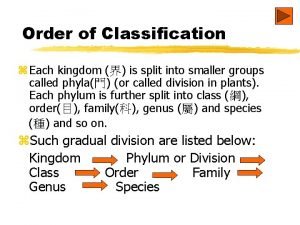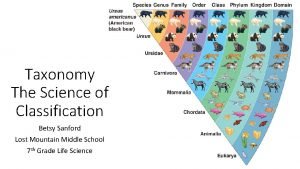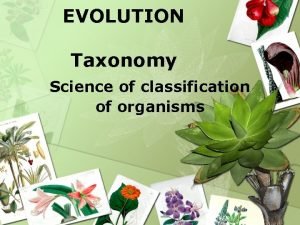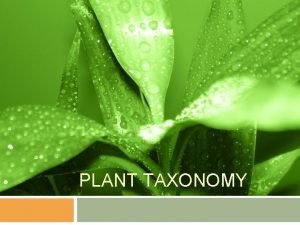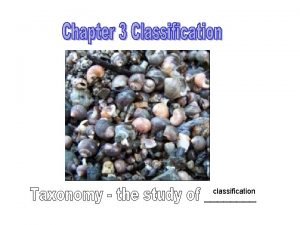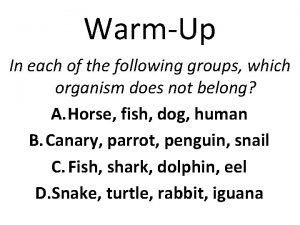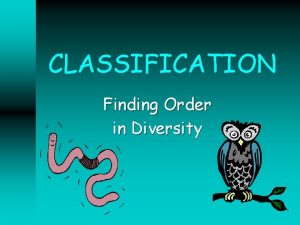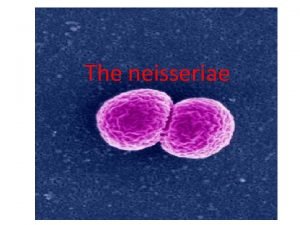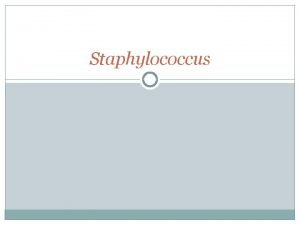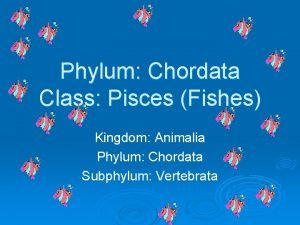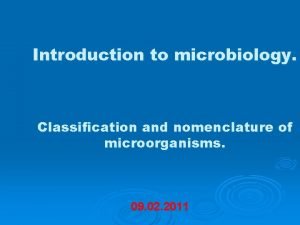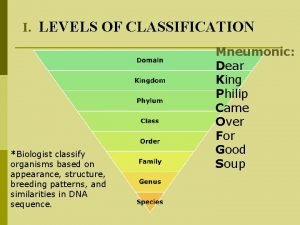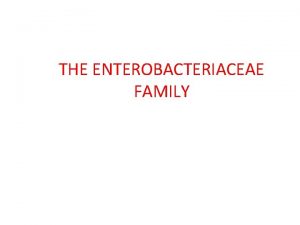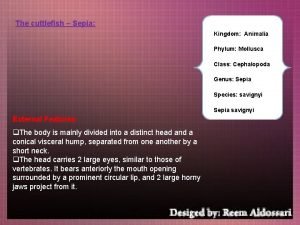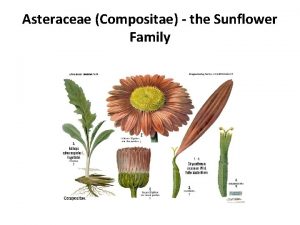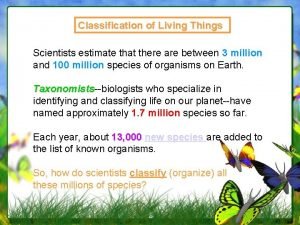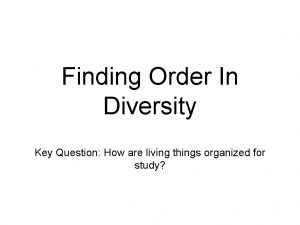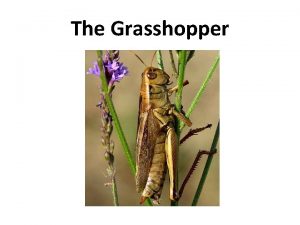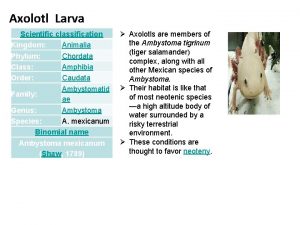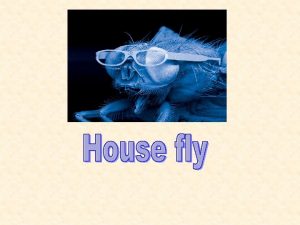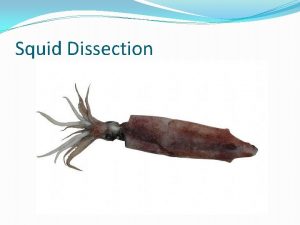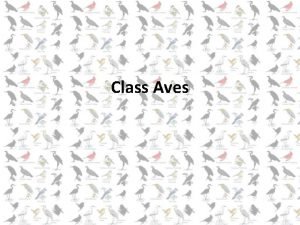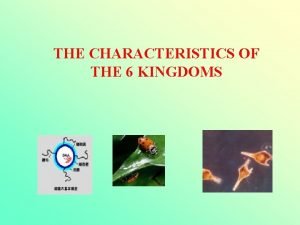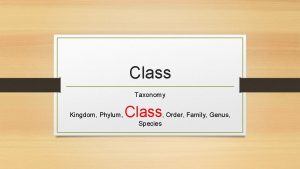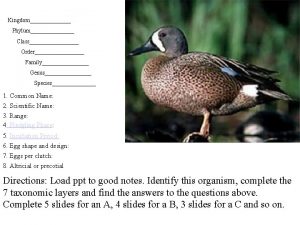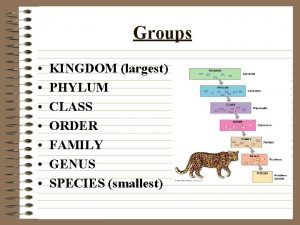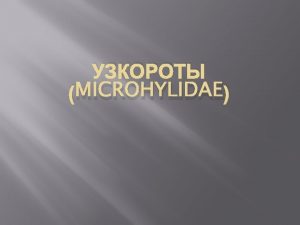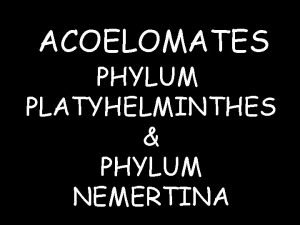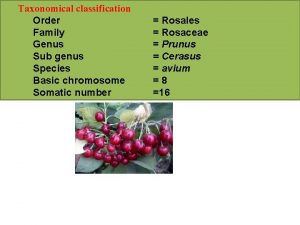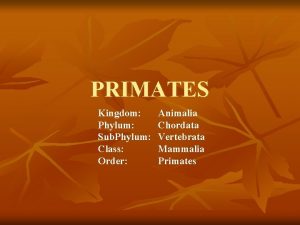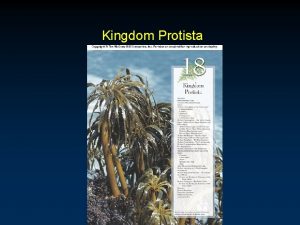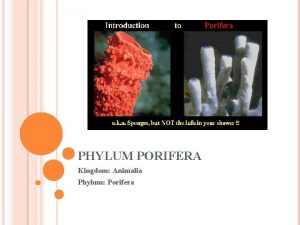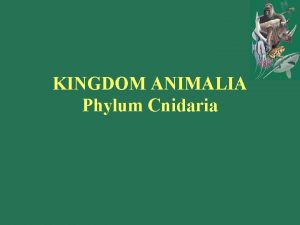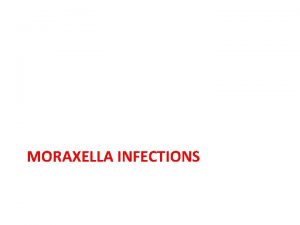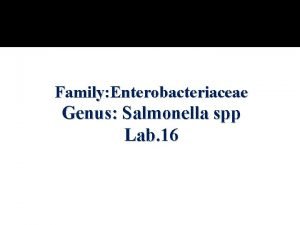Diversity Domain Kingdom Phylum Class Order Family Genus












































- Slides: 44

Diversity • • Domain Kingdom Phylum Class Order Family Genus Species


Archaea • - Single celled prokaryotes that reproduce asexually • 4 major phyla • Extremophyles • Have cell walls with no peptidoglycan • Diverse metabolic pathways

Bacteria cell Wall

Archaea • Methanogens • Live in the guts of cows, and termites to help digest cellulose in plant cell walls • C 02 ->Ch 4 (farts) • Methanobrevibacter smithii

Methanobrevibacter smithii Archaea Scientific classification Domain: Archaea Kingdom: Euryarchaeota Phylum: 1/10 th Class: Of human Order: Gut microbes!! 1/10 Euryarchaeota Methanobacteriales Family: Methanobacteriaceae Genus: Methanobrevibacter Species: M. smithii Binomial name Methanobrevibacter smithii Balch and Wolfe 1981

http: //www. colorado. edu/eeb/EEBprojects/schmidtlab/studentres/EBIO 3400/Lectu re 11. pdf (lots more differences!!!)


Eubacteria • Prokaryotic, single celled • Heterotrophic or autotrophic • Reproduce asexually with binary fission

Eubacteria • 1 circular chromosome and a secondary plasmid

Eubacteria • Classified based on shape, spores, metabolism(glycolysis for anaerobes , cellular respiration for aerobes), and ability to “gram stain”



Eubacteria

Eubacteria • Cyanobacteria (pond Scum) • Oscillatoria princeps • • D-Eubacteria K-Eubacteria P-Cyanobacteria C- Cyanophyceae O- Oscillatoriales F- Oscillatoria G- Oscillatoria S- O. princeps

Protista • Protista are simple, usually unicellular eukaryotic organisms. • Not animals, not plants, not fungi = Protist!! • Usually aquatic • Aerobic • Very important component of plankton • Reproduce sexually or asexually • Divisions (phyla) classified based on Animal like, Plant like or Fungus like

Protista • Animal like-> “Protozoa” – Rhizopoda – Apicomplexia – Zoomastigophora – Ciliophora

Protista • Division Rhizopoda • Move with a pseudopod (false foot) • Eat by engulphing food (phagacytosis)

Protista • Division Zoomastigophora • “Zooflagelates”

Protista • Division Ciliophora • example- Paramecium • Use cilia to move around

Protista Plantlike Protista-> “Algae” • contain chlorophyll and carry out photosynthesis • Very important aquatic primary producers – Dinoflagellata – Euglenophyta – Bacillariophyta – Chlorophyta – Phaeophyta – Rhodophyta

Protista • Bacillariophyta • The “diatoms”

Protista • Dinoflagellata • “Dinoflagelates” • Sometimes show biolluminescence • Red Tide

Protista • Euglenophyta – Unicellular flagellates – Primarily freshwater, but important in some marine environments – Many are heterotrophic (saprotrophic or phagocytic)

Protista • Chlorophyta • Green algae

Protista • Phenophyta • Brown Algae • Alt of Generations

Protista • Rhodophyta • Red Algae • Nori- Iodine source

Protista • Fungus like • Myxomycota- slime molds • Many nuclei for each giant cell full of cytoplasm • Use pseudopodia • The organisms in this group have a complex life cycle during the course of which they go through unicellular, multicellular, funguslike (form spores) and protozoanlike (amoeboid) stages.


Protista • Oomycota • Water molds • Some species (e. g. , Saprolegnia, Achyla) are parasites of fishes and can be a serious problem in fish hatcheries. • Downy mildews damage grapes and other crops. • Phytophthora infestans, the cause of the "late blight" of potatoes. In 1845 and again in 1846, it was responsible for the almost total destruction of the potato crop in Ireland. This led to the great Irish famine of 1845– 1860. During this period, approximately 1 million people starved to death and many more emigrated to the New World. By the end of the period, death and emigration had reduced the population of Ireland from 9 million to 4 million. • Phytophthora ramorum, which is currently killing several species of oaks in California. • Cell wall of cellulose, like plants •


Fungi • Eukaryotic, nonvascular, Heterotrophic, reproduce sexually and asexually with spores • Alternation of generations • N-2 N • Most are multicellular • Cell walls made of Chitin • Decomposers, parasites, or mutualists (Mycorrhizea on plant roots for N)

Fungi • Exoenzymes- digest food externally, then ingest it • Store food energy as glycogen, like animals • Vegetative-> Hyphae. Mycellium • Fruiting body-> Produces spores (the cap)


Fungi Phyla (based on spore arrangement) Chytridiomycota Zygomycota Asomycota Basiomycota

FUNGI Chytridiomycota (primitive Fungi) Sexual and asexual reproduction Spores are motile with a flagella

FUNGI Zygomycota (the molds) Sexual reproduction with spores with very thick walls

FUNGI

FUNGI Ascomycota- Sac Fungi -75 % of all fungi species -Sexual reproduction -Spores can be found in an ascus sac -Yeasts, Penicillium, truffels


FUNGI Basidiomycota- “da club fungi” -sexual spores are born externally on a club shaped basidium -Gills on fruiting body to increase surface area

Basidium


Pizza Mushroom D- Eukarya K- Fungi P- Basiomycota C- Hymenomycetes O- Agricales F- Agricaceae G- Agaricus S- A. Bispores
 Fibrobacteria
Fibrobacteria Kingdom family genus
Kingdom family genus Domain kingdom phylum
Domain kingdom phylum Genus order family
Genus order family Domain kingdom phylum
Domain kingdom phylum Domain kingdom phylum
Domain kingdom phylum Species genus family order
Species genus family order Family genus species order
Family genus species order Pig domain kingdom phylum class
Pig domain kingdom phylum class Euglena kingdom
Euglena kingdom Zea maize classification
Zea maize classification Taxonomic classification of horse
Taxonomic classification of horse Kingdom phylum class order of humans
Kingdom phylum class order of humans Classification of humans
Classification of humans King phillip came over for good soup
King phillip came over for good soup Kingdom phylum class
Kingdom phylum class Bacteria kingdom phylum class order
Bacteria kingdom phylum class order Bacteria kingdom, phylum, class, order
Bacteria kingdom, phylum, class, order Platypus class
Platypus class Pisces kingdom
Pisces kingdom Microorganisms definition
Microorganisms definition Cow kingdom phylum class order
Cow kingdom phylum class order Levels of taxonomy
Levels of taxonomy Famlya
Famlya Cuttlefish kingdom phylum class order
Cuttlefish kingdom phylum class order Compositeae
Compositeae Kingdom family genus species
Kingdom family genus species Species genus family order
Species genus family order Old kingdom middle kingdom new kingdom
Old kingdom middle kingdom new kingdom Nnn ruled
Nnn ruled Roman empire
Roman empire Old kingdom middle kingdom new kingdom
Old kingdom middle kingdom new kingdom Grasshopper subphylum
Grasshopper subphylum What are the eight levels of classification
What are the eight levels of classification What animal kingdom are axolotls in
What animal kingdom are axolotls in Snow leopard kingdom phylum class
Snow leopard kingdom phylum class Kingdom animalia phylum chordata class mammalia
Kingdom animalia phylum chordata class mammalia Diptera phylum
Diptera phylum Squid taxonomy classification
Squid taxonomy classification Bird air sac
Bird air sac Genetic diversity and biodiversity
Genetic diversity and biodiversity Genetic diversity vs species diversity
Genetic diversity vs species diversity 1st order 2nd order 3rd order neurons
1st order 2nd order 3rd order neurons What is global-analytic continuum
What is global-analytic continuum Characteristic of animal kingdom
Characteristic of animal kingdom


